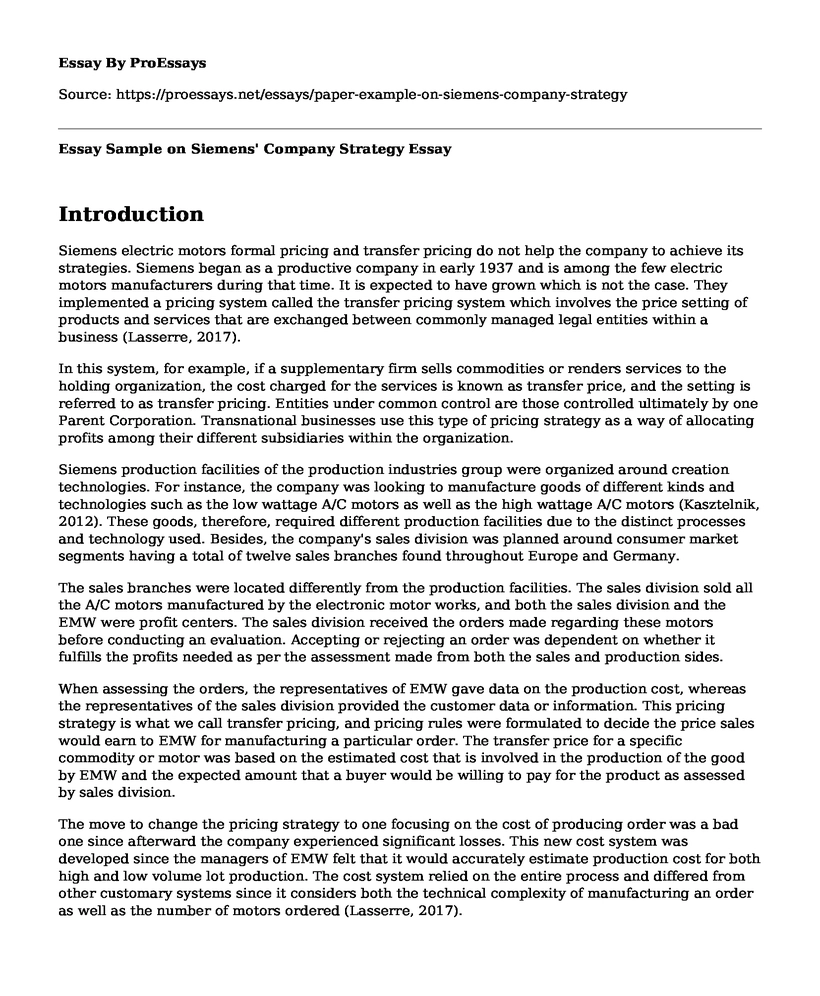Introduction
Siemens electric motors formal pricing and transfer pricing do not help the company to achieve its strategies. Siemens began as a productive company in early 1937 and is among the few electric motors manufacturers during that time. It is expected to have grown which is not the case. They implemented a pricing system called the transfer pricing system which involves the price setting of products and services that are exchanged between commonly managed legal entities within a business (Lasserre, 2017).
In this system, for example, if a supplementary firm sells commodities or renders services to the holding organization, the cost charged for the services is known as transfer price, and the setting is referred to as transfer pricing. Entities under common control are those controlled ultimately by one Parent Corporation. Transnational businesses use this type of pricing strategy as a way of allocating profits among their different subsidiaries within the organization.
Siemens production facilities of the production industries group were organized around creation technologies. For instance, the company was looking to manufacture goods of different kinds and technologies such as the low wattage A/C motors as well as the high wattage A/C motors (Kasztelnik, 2012). These goods, therefore, required different production facilities due to the distinct processes and technology used. Besides, the company's sales division was planned around consumer market segments having a total of twelve sales branches found throughout Europe and Germany.
The sales branches were located differently from the production facilities. The sales division sold all the A/C motors manufactured by the electronic motor works, and both the sales division and the EMW were profit centers. The sales division received the orders made regarding these motors before conducting an evaluation. Accepting or rejecting an order was dependent on whether it fulfills the profits needed as per the assessment made from both the sales and production sides.
When assessing the orders, the representatives of EMW gave data on the production cost, whereas the representatives of the sales division provided the customer data or information. This pricing strategy is what we call transfer pricing, and pricing rules were formulated to decide the price sales would earn to EMW for manufacturing a particular order. The transfer price for a specific commodity or motor was based on the estimated cost that is involved in the production of the good by EMW and the expected amount that a buyer would be willing to pay for the product as assessed by sales division.
The move to change the pricing strategy to one focusing on the cost of producing order was a bad one since afterward the company experienced significant losses. This new cost system was developed since the managers of EMW felt that it would accurately estimate production cost for both high and low volume lot production. The cost system relied on the entire process and differed from other customary systems since it considers both the technical complexity of manufacturing an order as well as the number of motors ordered (Lasserre, 2017).
The evaluation was based on the estimation of the materials required to produce a motor by examining the actual resources used in the manufacturing of similar products. Then they calculated the standard unit cost for a single order by estimation of the direct material or resources and direct cost of labor, and afterward assigning estimated overhead prices as if the plant working at 80% of capacity. The cost system divided overhead costs into five sections: material related overhead, cost of handling custom components, production-related overhead, cost of order processing, and support related overhead.
The different kinds of transfer pricing strategies were employed by the company to ensure it achieves profits despite them not being useful in the fundamental purpose (Kasztelnik, 2012). For example, the EMW transferred motors to the sales at a certain price after first evaluating to analyze if the order will earn profits. After considering all the production costs, the EMW will then decide on the most effective rate, although the sales division had to check whether the cost would be acceptable by the customer or not before approving the price.
Conclusion
The transfer pricing rules were created relying on historical information and developed so that over the whole corporate cycle, EMW achieved a state where they neither get loses nor profits. Under this system, EMW had experienced or averaged zero earnings for the previous five years. The organization would see minimal profits in a good year, as well as minimal loses in a bad year. The two transfer pricing rules were recognized by examining the price structure of the low wattage A/C motor trade at average capacity utilization over the corporate cycle. Therefore, from the minimal losses and minimal profits experienced by the firm, it is evident that the pricing strategies did not help Siemens achieve its company strategy.
References
Kasztelnik, K. M. (2012). Corporate Transfer Pricing in Selected Multinational Companies Headquartered in the United States (Doctoral dissertation, Walden University).
Lasserre, P. (2017). Global strategic management. Macmillan International Higher Education.
Cite this page
Essay Sample on Siemens' Company Strategy. (2022, Oct 15). Retrieved from https://proessays.net/essays/paper-example-on-siemens-company-strategy
If you are the original author of this essay and no longer wish to have it published on the ProEssays website, please click below to request its removal:
- Brand Is Power Essay Example
- Digital Marketing vs Traditional Marketing Paper Example
- Essay Example on Sustainability in the Hotel Industry: Protecting Environment, Creating Jobs
- International Expansion: Navigating the Competitive Global Marketplace - Research Paper
- Essay Example on Colour Matters: Powerful Tool in Brand Marketing
- Celebrity Endorsement & Its Impact on Branding Strategies - Essay Sample
- Disruptive Tech: How It's Transforming Organizations & Consumers - Essay Sample







